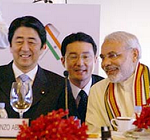Prime Minister Narendra Modi’s visit to Japan from August 30 to September 3 is significant for a bilateral relationship that has never managed to take off despite the absence of any historical or ongoing negative dimensions. The biggest obstacle since India’s nuclear tests in 1974 has been Tokyo’s restraint on the nuclear programme; Japan is the only country in the world that has been a victim of nuclear weapons.
Meanwhile, strategic equations, global and regional, have changed beyond recognition with the economic and military rise of China, as well as its declared search for parity and a new type of “great power” relationship with the U.S. But the immediate pressure is felt in Asia—by India with its 5,045 kilometre-long disputed land border with China, and by Japan, Vietnam and the Philippines, which have conflicting claims with China over neighbouring islands.
If the India-Japan civil nuclear cooperation agreement—being negotiated since 2010—is concluded during this visit, it can unlock the strategic and economic potential of the relationship. It will also enable multinational companies like GE-Hitachi to invest in India’s nuclear energy sector.
Among Japanese leaders, Prime Minister Shinzo Abe has been the most explicit in articulating the potential of India-Japan relations. In 2007, in an address to the Indian Parliament, Abe said that “a strong India is in the best interest of Japan, and a strong Japan is in the best interest of India.”1 His early apprehension of Chinese expansionism probably underlay Japan’s concept of a “strategic quadrilateral” with India, Australia and the U.S.
Cooperation in the quadrilateral framework is now underway, with Modi’s forthcoming visit to Washington and Australian prime minister Tony Abbot’s visit to India on September 4 to iron out a civil nuclear agreement.
On the economic front, while annual bilateral trade is only around $16 billion, Japan’s interest in India has been pronounced.2 India is the largest recipient of Japanese ODA worth nearly $38 billion cumulatively (till 2013).3 Suzuki Motor Corporation’s early landmark investment in India in the early 1980s transformed the automobile sector. Despite the subsequent arrival of American, European and Korean automobiles in the Indian market, Maruti Suzuki still holds a market share of 42% in 2013-2014.4
In recent months, Modi’s perceived decisiveness has been interpreted in Japan—and elsewhere—as India becoming a more significant presence in the international arena, while it seeks to revive domestic economic growth.
Japan is one of the few countries that has high foreign exchange reserves—$1.3 trillion—and its companies are looking for high-yield investment destinations.5 This can therefore be an important moment: given the political difficulties with China, Japan is seeking to invest elsewhere to balance the scale of its investments in China.
China received $31.5 billion of aid from Japan and $40.4 billion of FDI through the 1980s and 1990s, which fuelled the Chinese economic miracle.6 But it has remained harshly critical of Japanese atrocities in the Second World War. Therefore, in addition to its defence treaty relationship with the U.S., Japan has initiated strategic partnerships with Vietnam and the Philippines. And Japan continues to seek more substantive defence cooperation with India.
However, it is cautious and its companies tend to move in groups. If India can address their regulatory anxieties, Japanese investment could cascade into India. For example, India does not have the resources for infrastructure development and Japan has been a fruitful partner in this sector in the past, as is evident in the Delhi-Mumbai Industrial Corridor and the Delhi Metro.
A rampant China and the critical need for freedom of navigation in the seas—Japan is cognisant of India’s location at the centre of sea lanes—adds to the strategic convergence. As does the fact that India and Japan both depend on energy imports from the Gulf. These factors mandate greater naval cooperation between the two countries.
India and Japan must also develop a long term perspective. Japan’s willingness to supply the US/2 amphibious aircraft to India is extremely significant. This will potentially be Japan’s first defence exports to any country other than its treaty partner, the U.S. If India does import defence equipment from Japan, it will give the relationship a special flavour and enable the two to eventually move towards joint development and production of defence equipment.
China will not be the only country watching India’s strategic and economic relations with Japan. The U.S. and Australia may view the evolving relationship benignly and perhaps even supportively. Russia and South Korea—who have disputes with Japan, but are also India’s strategic and trade partners, respectively—will be more cautious.
At the same time, all the countries, including India, have intricate economic dependencies with China, which too will not want strategic rivalries to disrupt market access, and sources of natural resources and technology. Therefore, while Modi must be sensitive to differences among Japan’s neighbours, he need not curtail India’s expanding ties with Tokyo.
Neelam Deo is Co-founder and Director, Gateway House: Indian Council on Global Relations; She has been the Indian Ambassador to Denmark and Ivory Coast; and former Consul General in New York.
You can read more exclusive content from Gateway House, here.
For interview requests with the author, or for permission to republish, please contact outreach@gatewayhouse.in.
© Copyright 2014 Gateway House: Indian Council on Global Relations. All rights reserved. Any unauthorized copying or reproduction is strictly prohibited
References
1. Ministry of Foreign Affairs of Japan, Confluence of the Two Seas-Speech by H.E.Mr. Shinzo Abe, Prime Minister of Japan at the Parliament of the Republic of India, 22 August 2007, <http://www.mofa.go.jp/region/asia-paci/pmv0708/speech-2.html>
2. Ministry of External Affairs, Government of India, India-Japan Relations, July 2014, <http://www.mea.gov.in/Portal/ForeignRelation/Japan_-_July_2014_.pdf>
3. Ministry of Finance, Government of India, Japan Division, <http://finmin.nic.in/the_ministry/dept_eco_affairs/japan/japan_index.asp>
4. Maruti Suzuki, Annual Report 2013-14, <https://marutistorage.blob.core.windows.net/marutisuzukipdf/Maruti%20AR%202014
%20cover%20to%20cover%20dt%2006-08-14%20Deluxe.pdf>
5. International Monetary Fund, Japan – International Reserves and Foreign Currency Liquidity, <https://www.imf.org/external/np/sta/ir/IRProcessWeb/data/jpn/eng/curjpn.htm>
6. Ministry of Foreign Affairs of Japan, Overview of Official Development Assistance (ODA) to China, <http://www.mofa.go.jp/policy/oda/region/e_asia/china/> , and Jetro, Japan’s Outward FDI by Country/Region, 2013, <http://www.jetro.go.jp/en/reports/statistics/data/country1_e_13cy.xls>


